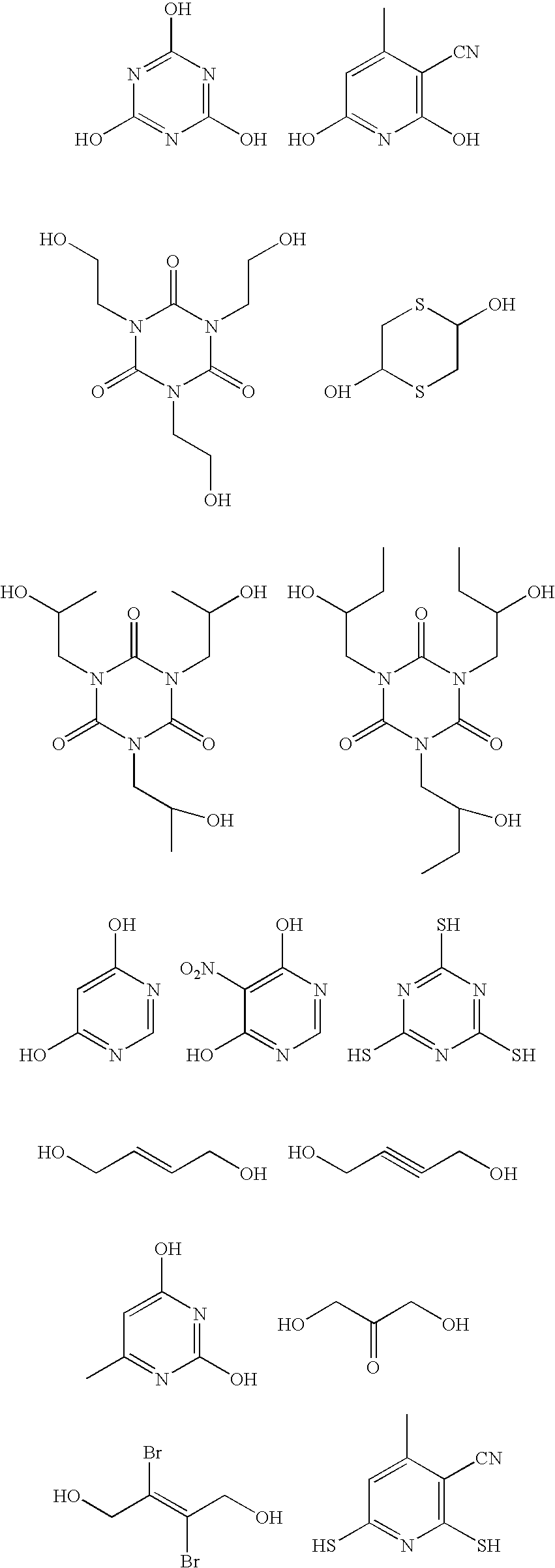Antireflective coating compositions
a coating composition and anti-reflective technology, applied in the direction of photosensitive material processing, basic electric elements, electric devices, etc., can solve the problems of back reflectivity, thin film interference effect, reflective notching
- Summary
- Abstract
- Description
- Claims
- Application Information
AI Technical Summary
Benefits of technology
Problems solved by technology
Method used
Image
Examples
synthesis example 1
[0058]32 grams of tetramethoxymethyl glycoluril, 13 grams of tris-(2-hydroxyethyl)cyanuric acid and 100 grams of cyclohexanone were charged into a 500 mL flask with a thermometer, a cold water condenser and a mechanical stirrer. The reaction mixture was heated to 80° C. After a catalytic amount of para-toluenesulfonic acid monohydrate (0.14 g) was added, the reaction was maintained at this temperature for 6.0 hours. The reaction solution was then cooled to room temperature and a ˜30 solid % polymer solution was obtained. The average molecular weight of the polymer is about 2000 g / mol.
synthesis example 2
[0059]29 grams of tetramethoxymethyl glycoluril, 16 grams of tris-(2-hydroxyethyl)cyanuric acid and 100 grams of cyclohexanone were charged into a 500 mL flask with a thermometer, a cold water condenser and a mechanical stirrer. The reaction mixture was heated to 80° C. After a catalytic amount of para-toluenesulfonic acid monohydrate (0.14 g) was added, the reaction was maintained at this temperature for 6.0 hours. The reaction solution was then cooled to room temperature and a ˜30 solid % polymer solution was obtained. The average molecular weight of the polymer is about 2000 g / mol.
synthesis example 3
[0060]6.1 g acetic anhydride, 13 grams of tris-(2-hydroxyethyl)cyanuric acid and 120 grams of cyclohexanone were charged into a 500 mL flask with a thermometer, a cold water condenser and a mechanical stirrer. The mixture was heated to 100° C. and 0.11 g of para-toluenesulfonic acid monohydrate was added. After 16 h, the reaction mixture was cooled to 80° C. and 32 grams of tetramethoxymethyl glycoluril was added. The reaction was maintained at this temperature for 16.0 hours. The reaction solution was then cooled to room temperature and a polymer solution was obtained.
PUM
| Property | Measurement | Unit |
|---|---|---|
| refractive index | aaaaa | aaaaa |
| refractive index | aaaaa | aaaaa |
| refractive index | aaaaa | aaaaa |
Abstract
Description
Claims
Application Information
 Login to View More
Login to View More - R&D
- Intellectual Property
- Life Sciences
- Materials
- Tech Scout
- Unparalleled Data Quality
- Higher Quality Content
- 60% Fewer Hallucinations
Browse by: Latest US Patents, China's latest patents, Technical Efficacy Thesaurus, Application Domain, Technology Topic, Popular Technical Reports.
© 2025 PatSnap. All rights reserved.Legal|Privacy policy|Modern Slavery Act Transparency Statement|Sitemap|About US| Contact US: help@patsnap.com



